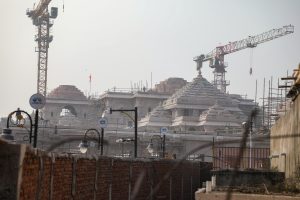Sudesh Jaiswal was 36 years old when he, among thousands of people in the shape of a mob, participated in razing the Babri Masjid to the ground on December 6, 1992. The 16th-century mosque stood in the heart of Ayodhya, at the site of the Ramjanmabhoomi, where many Hindus believe that their deity Ram was born.
Thirty-two years later, Jaiswal says his “dream has come true.” His long-cherished dream of seeing a grand Ram temple come up where the mosque once stood has been fulfilled.
“I am at peace today. It was a long wait. Our Ram-ji (Hindu God) had to wait 500 years to return home,” exclaimed Jaiswal, who sells tea now at a roadside stall, just a few hundred meters from the place where the temple is under construction.
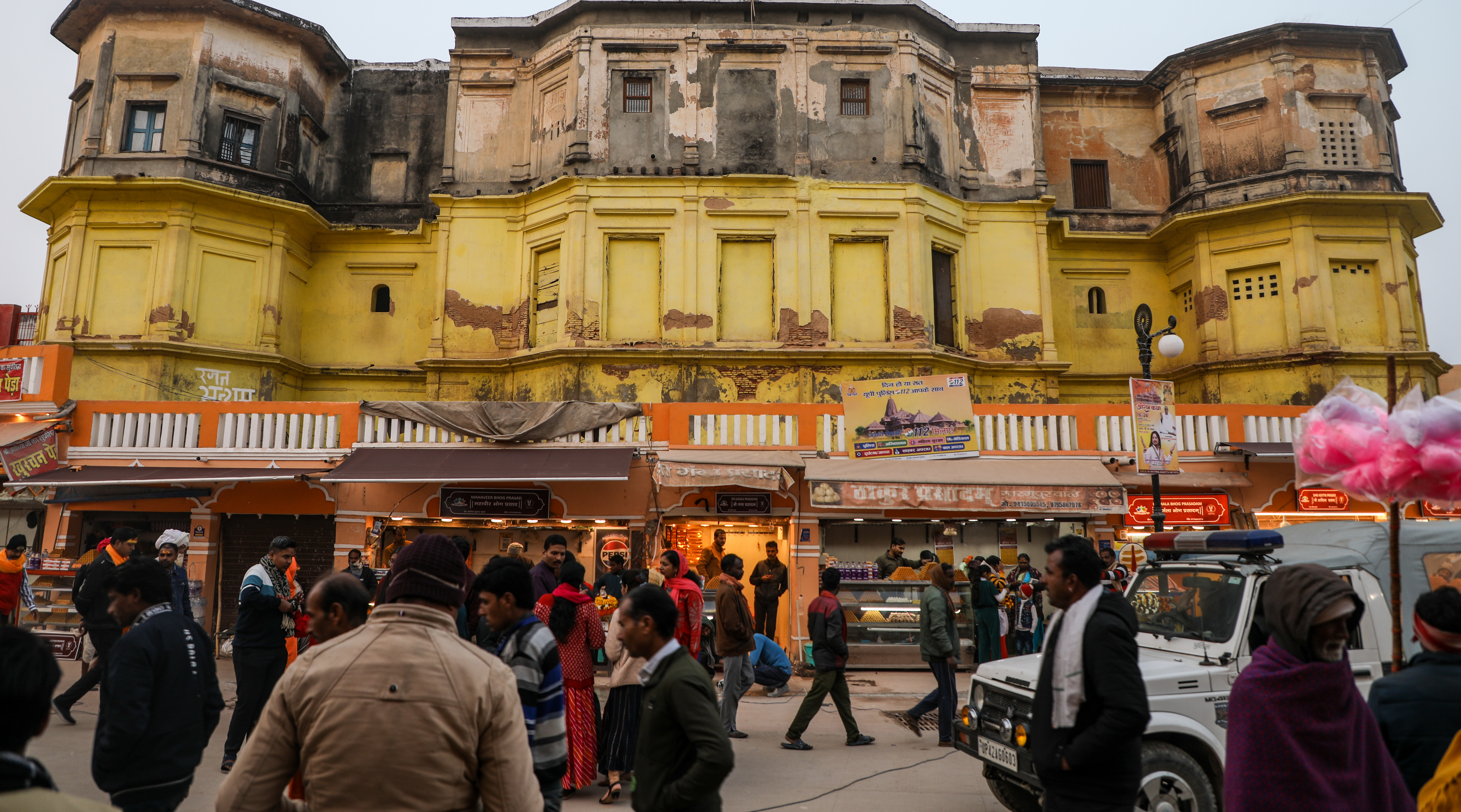
A festive mood on the streets of Ayodhya, India, January 12, 2024. Photo by Luqmaan Zeerak.
Ayodhya has been the subject of a long-standing dispute between Hindus and Muslims in Hindu-dominated India. While Hindus believe that the site of the mosque is the birthplace of one of their most revered deities, Lord Ram, Muslims say they prayed at the mosque for generations until 1949 when an idol of Ram was surreptitiously placed inside the mosque.
The dispute took an ugly turn on December 6, 1992, when the right-wing Vishva Hindu Parishad (VHP) and the Bharatiya Janata Party (BJP) organized a rally involving around 150,000 people at the site. The rally turned violent and the participants tore down the mosque. A subsequent inquiry into the incident found 68 people responsible, including several BJP and VHP leaders.
With the BJP coming to power in the center in 2014 and winning a second term in 2019, the position of Hindutva groups gained support from the courts. On November 9, 2019, a five-judge bench of the Supreme Court unanimously ruled in favor of the Hindu groups; the site was handed to them. It said that alternate land must be allotted to the Sunni Waqf Board for the construction of a mosque. Then on September 30, 2020, the apex court acquitted all those accused in the 1992 razing of the mosque, on account of “inconclusive evidence.”
Jaiswal is proud of his role in the demolition of the Babri Masjid. He described it as his “religious duty.”
“Today we are bearing the fruits of what we did back then [in 1992]. We had to struggle a lot to reach here [construction of the temple]. It is Ram’s blessing, nothing else,” Jaiswal said.
Political Messaging
The consecration of the Ram Temple is scheduled for January 22, and Ayodhya wears a festive look. The chants of “Jai Shri Ram” (Victory to Lord Rama) reverberate in every nook and corner of Ayodhya. Devotees from across India are thronging the town.
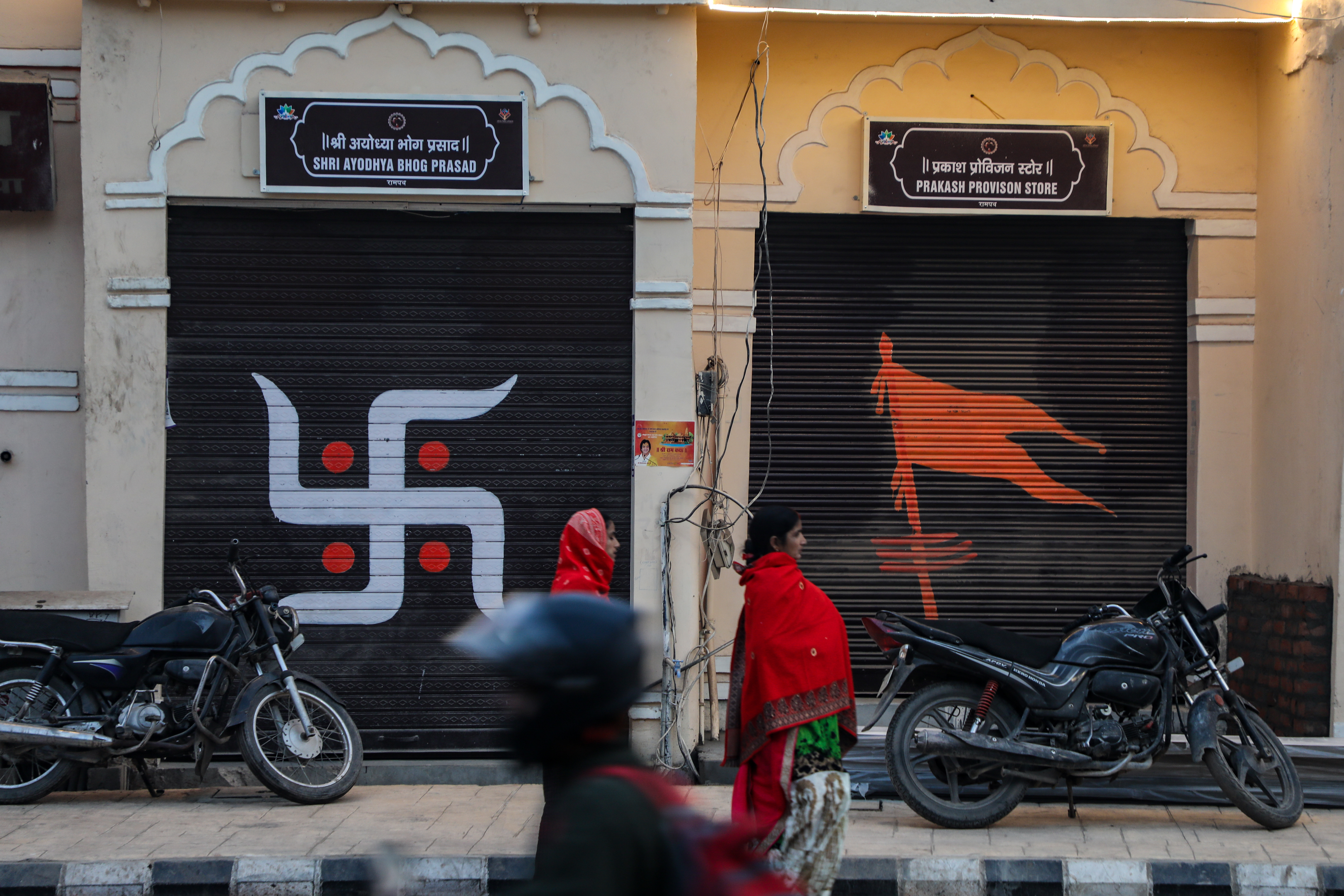
Hindu symbols painted on the shutters of shops in Ayodhya, India, January 12, 2024. Photo by Luqmaan Zeerak.
The market on the pathway to the temple has been revamped. Ayodhya’s streets and shops are bedecked with decorations with a Hindu theme. Images of the Swastika, calligraphy of Shri Ram, bows and arrows, and saffron flags flutter everywhere. Shops have a uniform look; their shutters are painted brown and they have identical nameplates.
Ayodhya is in the grip of a religious fever. However, there is a loud political messaging as well. Prime Minister Narendra Modi is being hailed as a “savior;” devotees see him as nothing less than an avatar (manifestation) of Ram. He is the one who made this all possible, they say.
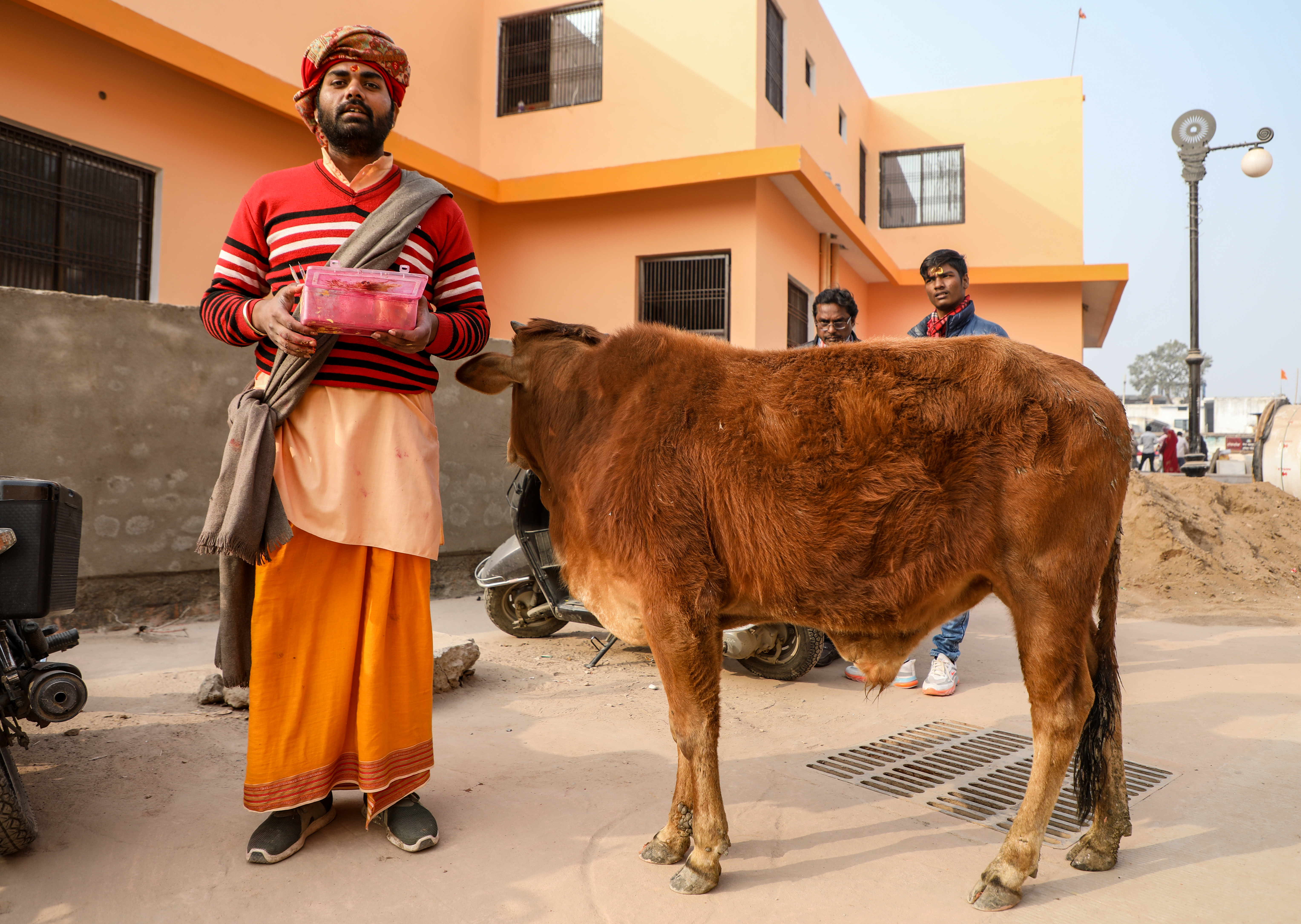
Sachin Tripathi stands with his calf outside at the gates of the Ram Temple in Ayodhya, India, January 12, 2024. Photo by Luqmaan Zeera.
Thirty-year-old Sachin Tripathi has devoted his life to the welfare of the Ram Temple. Standing just a few meters outside from the temple’s main gate, he marks the forehead of every devotee with “Jai Shri Ram” in the Hindi script.
After building the Ram Temple, the Modi government’s next mission should be to free the “birthplace” of Lord Krishna in Mathura from the “shackles” of Muslims, Tripathi said.
“Modi and [Uttar Pradesh Chief Minister] Yogi are mahapurush (great men). It is the blessing of Ram that these two have become our saviors. I am their devotee as much as I am of Ram-ji,” Tripathi said. “I am eagerly waiting to see them together on January 22.”
Citing the huge rush of devotees on the consecration day, the Uttar Pradesh government has decided to close down the city between January 17 and 22 for outsiders, who are not invited. Strict instructions have been issued to hoteliers and guest house owners not to take any bookings during this period.
However, thousands of devotees have decided to visit Ayodhya anyway, despite the administration’s orders. Planning to camp on the town’s peripheries till January 22, they have brought tents, blankets, sleeping bags, utensils and eatables.
Seventy-five-year-old Halkveer Yadav, a priest, has traveled from Bhopal, a city in Madhya Pradesh that is 492 miles from Ayodhya. He is carrying a letter from a local administration to be allowed to stay in Ayodhya.
“I want to see Modi and Yogi together placing Lord Ram in his home,” Yadav said, adding that “it was because of them that this long-awaited dream has turned into a reality.”
“What has Congress done for us [Hindus] all these years? They are happy to serve Muslims only. Now, we have our own Hindu leader,” he said.
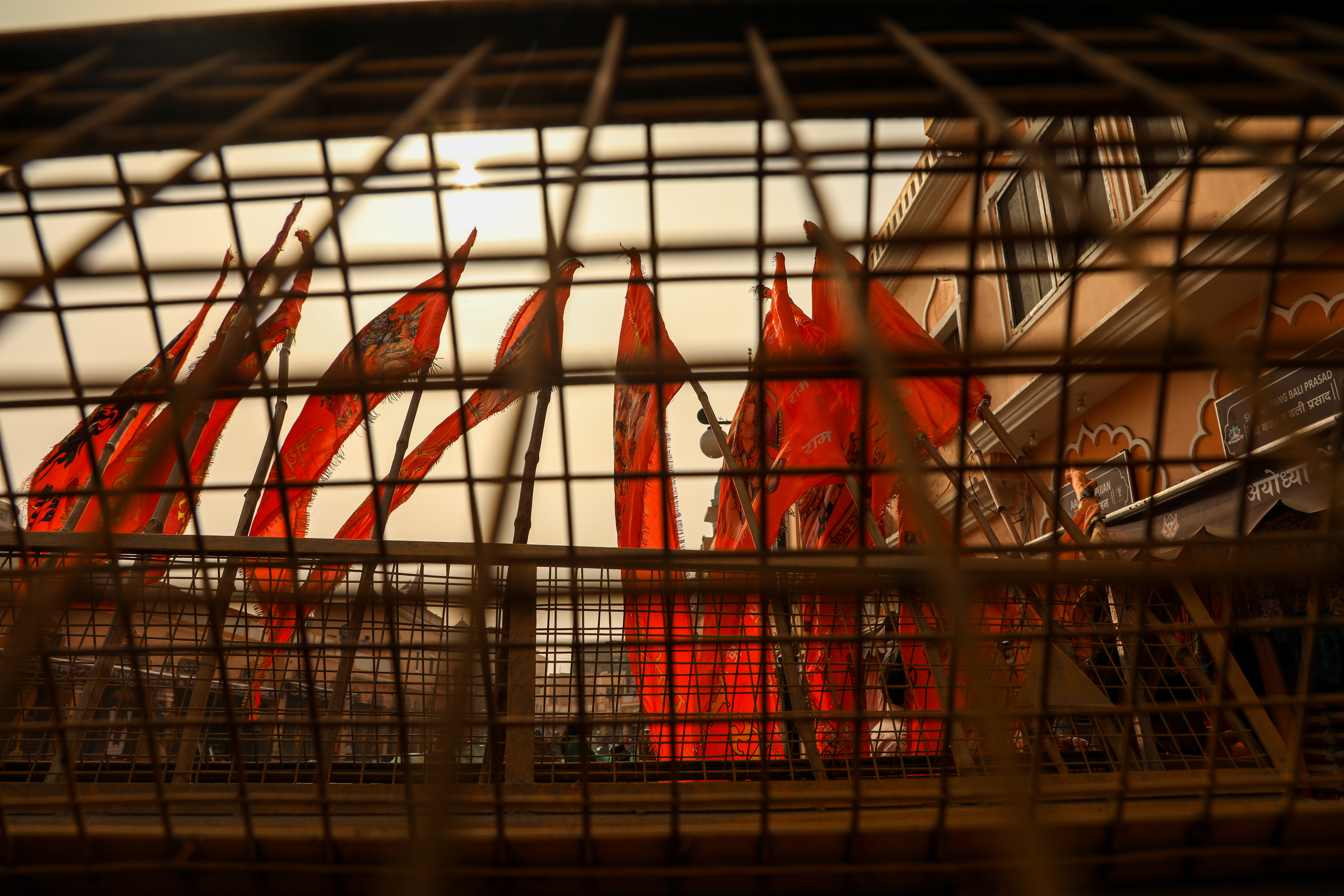
Saffron flags unfurled on the streets of Ayodhya, India, January 12, 2024. Photo by Luqmaan Zeerak.
A family of 22 members from Alirajpur in Madhya Pradesh shares a similar point of view. Crediting the construction of the temple to the Modi government, they said the country needs a leader like him.
“I am happy to be here. The atmosphere is cheerful. All praise to Modi. He is definitely going to continue as our PM after the next elections as well,” Gautam Ravat, 21, the youngest in the family, said.
The temple construction holds cultural and religious significance for many Hindus, and the BJP’s involvement in the process has been part of their Hindutva ideology, which aims at establishing Hindu hegemony.
On August 5, 2020, the groundbreaking ceremony (laying the foundation stone) for the temple was attended by several political leaders. Modi was the center of attention.
This time, the VHP and the Rashtriya Swayamsevak Sangh (RSS), which is the BJP’s ideological fount, are planning to telecast the temple’s consecration event on giant screens across the country.
Though the temple construction will not be completed until at least 2027, Modi is inaugurating it now. The mobilization of Hindus towards the religious site is part of the BJP’s strategy to galvanize the Hindu majority ahead of the general elections slated for April-May. Indeed, the consecration ceremony was one of the main items on the agenda of the BJP’s two-day deliberations in December last year to chalk out its strategy for the 2024 general elections.
Corroborating this in a post on X, formerly Twitter, Home Minister Amit Shah, who is a close aide of Modi, said: “We have to reach every home with our ideology and historic works of BJP governments and make Modi-ji prime minister again in 2024 with an unprecedented majority.”
The Congress party is among several opposition parties that have decided to keep away from the consecration ceremony on the grounds that it is an “out and out political event.” This has given the BJP enough ammunition to label them “anti-Hindu.”
“Due to its feelings of jealousy, malice and inferiority complex towards Prime Minister Narendra Modi, the Congress had gone to the extent of opposing the country and is now opposing God,” BJP spokesperson Sudhanshu Trivedi told journalists at the party’s headquarters in New Delhi on January 11.
Importantly, the four Shankaracharyas who head the four main Hindu mutts or monasteries, have decided not to attend the ritual. According to them, holding the consecration ceremony at an under-construction temple is against the rules of the Sanatan Dharma or Hinduism.
Meanwhile, the BJP is leaving no stone unturned to create a big spectacle out of the consecration ceremony. They are taking all credit for what they call the fulfillment of the aspiration of a billion Hindus. Modi and top leaders will be the focus of all cameras on January 22. Over a hundred thousand devotees are expected to join the event in addition to 4,000 guests from India and abroad.
A Ram Temple at What Cost?
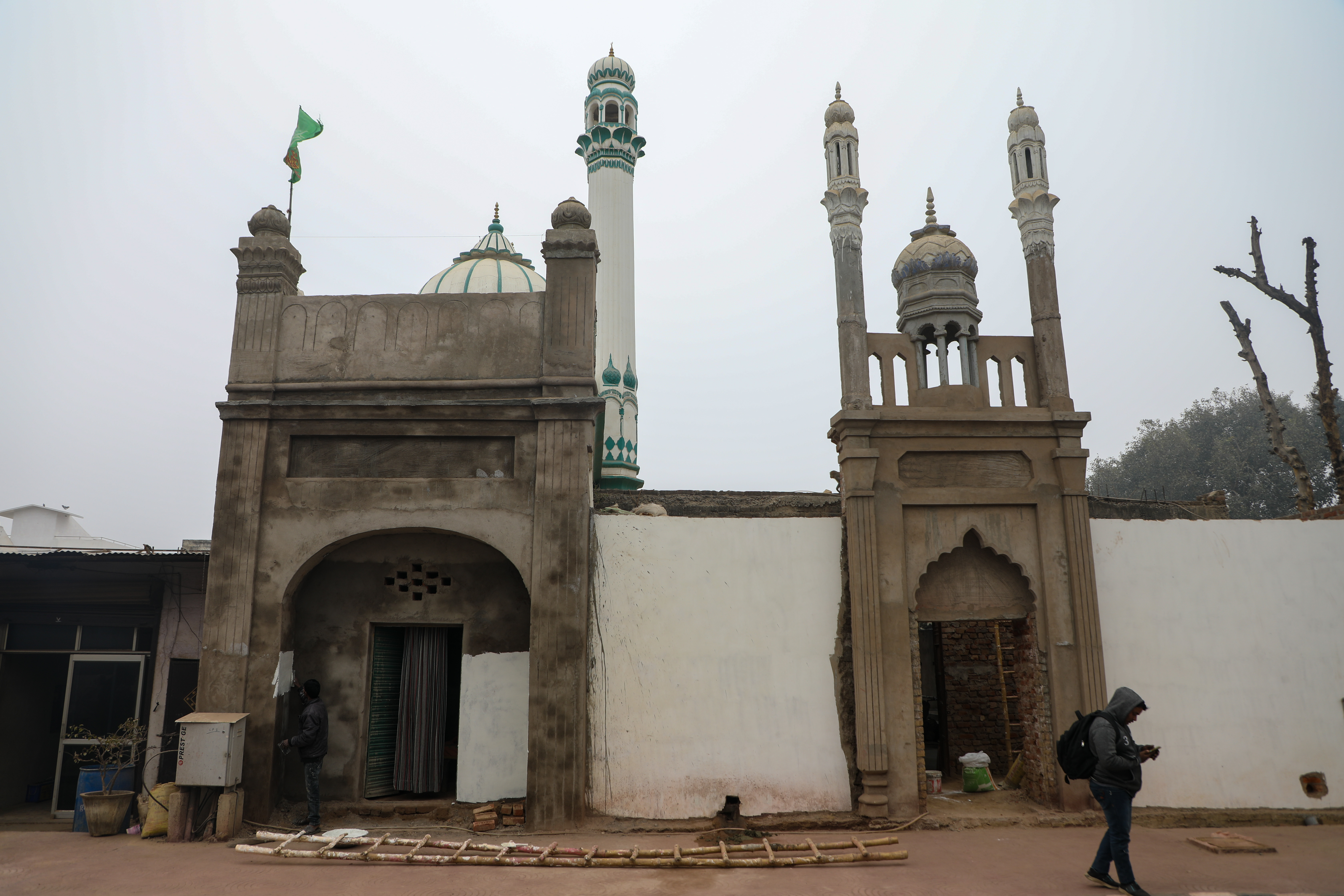
Malik Shah Mosque undergoing repair after being partially demolished for road widening, Ayodhya, India, January 13, 2024. Photo by Luqmaan Zeerak.
Even as the country is abuzz with “Lord Ram’s homecoming,” locals in Ayodhya are paying a heavy price. The government’s road widening project has led to the demolition of 2,200 shops, 800 houses, 30 temples, nine mosques, and 6 tombs.
Nand Kumar Gupta, president of a traders’ union, the Ayodhya Udyog Vyapar Mandal, said that many people have lost their livelihood in the process with little or no compensation provided from the government.
“Everybody is lost in the spectacle of Lord Ram’s temple. But I want to ask the government and the media, at what cost is this temple being built,” Gupta said. He has been leading a protest against the demolition drive without much success.
Gupta is “facing the heat” from the authorities for leading the protest. He alleged that police are consistently “raiding” his house, while many of his business ventures have either been “jeopardized or completely shut down.”
“My mineral water plant was closed down. I have been kept under house arrest many times. Even my electricity supply was cut many times to pressurize me to give up the agitation against the government,” he claimed.
Terming the consecration of the Ram temple as a “political stunt” by the BJP for the upcoming elections, Gupta believes that the right-wing party would use the event to garner votes.
“When you talk about the Taj Mahal, you always remember [the Mughal emperor] Shah Jahan who built it. Nobody remembers the workers who gave their lives to build it. Similarly, as long as the Ram Temple stands people will remember Modi, nobody will remember us [locals], who were made to lose their houses and livelihood for it,” he said.
A shopkeeper selling bangles in the Ayodhya market, who spoke on condition of anonymity fearing reprisal from the authorities, said he was reduced to extreme poverty after his shop was demolished in the road-widening project.
Less than two miles away from “Ram’s birthplace” is a decades-old mosque, half of which was also demolished to widen the road leading to the Ram Temple.
Fifty-year-old Mohammad Shahzad Khan, the mosque’s caretaker, said that the administration ignored his pleas to not demolish the building.
“Only 10 to 12 Muslim families are living here. The rest of the families, who were living in shanties, were evacuated in the demolition process from this place,” Khan said. The mosque, which his 95-year-old mother built, is the only visible sign of a Muslim identity in the area.
A butcher by profession, Khan was forced to close his meat shop when guidelines that no “meat and alcohol shops” would be allowed in the area around the temple were issued.
“They [the authorities] have tried many things to remove us from this place, but my family is not going anywhere. They have to kill us if they want to occupy this place,” said Khan, who lives in a two-room house adjacent to the mosque with his mother, two sons, a daughter-in-law, and a grandson.
Deserted Piece of Land
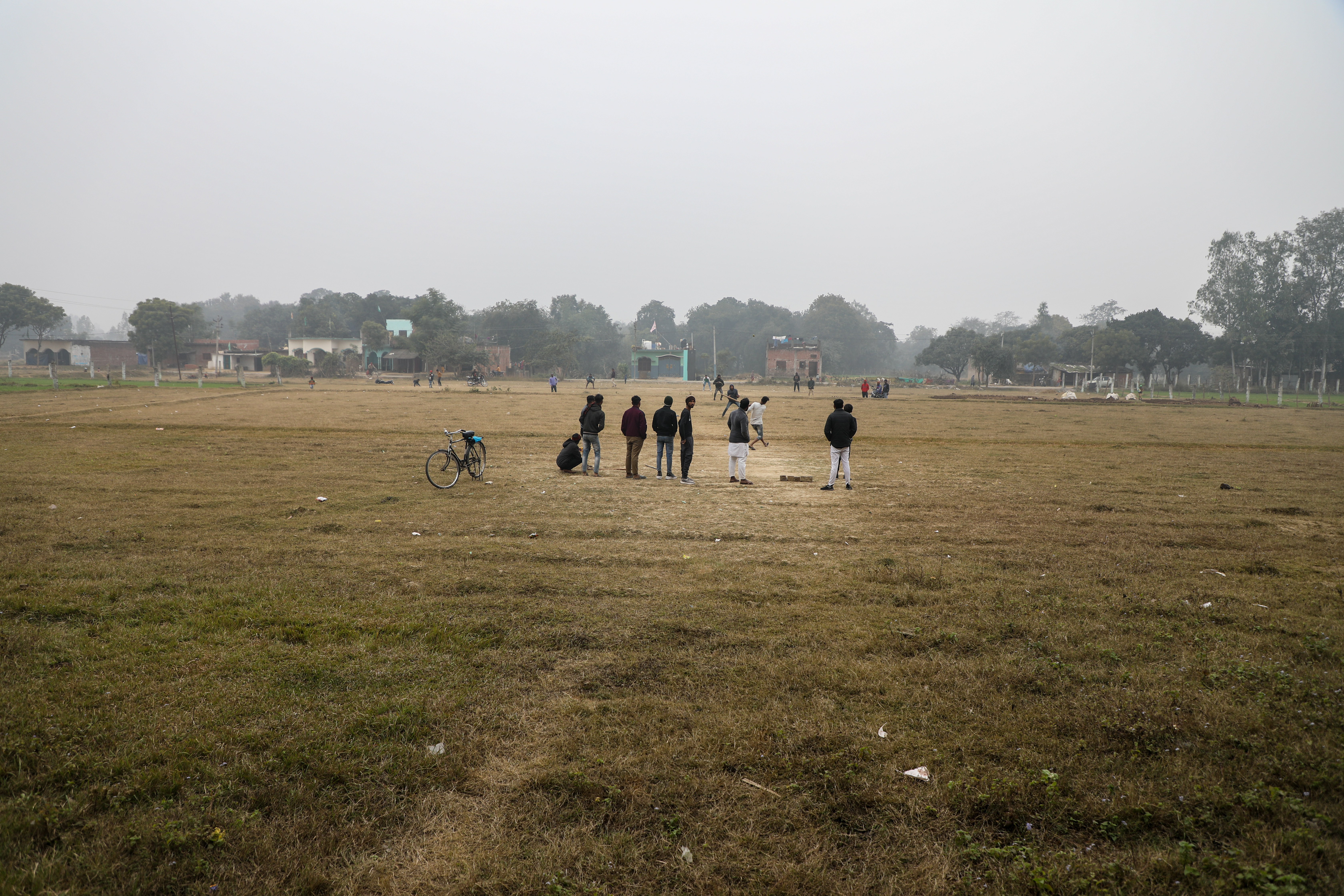
Boys playing cricket on the land allotted for construction of a mosque at Dhannipur village in Ayodhya district, India, January 13, 2024. Photo by Luqmaan Zeerak.
Far away from the hustle and bustle of Ayodhya’s streets is a 5-acre deserted plot of land that has become a children’s playground.
The Supreme Court had allotted this land to the Muslim community as an alternative to the Babri Masjid. It is located at Dhannipur village, 15 miles away from the now-demolished Babri Masjid.
The Waqf Board had prepared the blueprint to build a mosque here, along with a cancer hospital, a law college, and a community kitchen. But a shortage of funds has prevented the project, which is estimated to cost $3.62 billion, from taking off.
Sohrab Khan, who represents the Waqf Board, said that lack of funds has delayed the project all these years. But he is optimistic. “We have received the clearance from the administration. Once the funds are available the construction will start,” he said.
The village inhabited by a population of 1,575 people of different faiths has lived in harmony. But the pain of losing the Babri Masjid is vivid in the memory of the Muslims.
“No Muslim would be happy to see a historic mosque being razed to the ground. But what can we do, we have to abide by the Supreme Court’s decision now,” a 65-year-old local, Jan Mohammad, said.
On the western part of the land dedicated to the upcoming mosque is a shrine of the revered Sufi saint Hazrat Abdul Rehman Saani Seherwadi. But few devotees visit.
Locals said they are hopeful that once the mosque is constructed, people from across the country would visit the village.
“Maybe it was Allah’s will that a mosque of such stature be built in our village. It will help our village to see prosperity,” another local, Afroz Khan, said.
“But we can never forget our Babri Masjid. It will always remain in our hearts,” he added.













